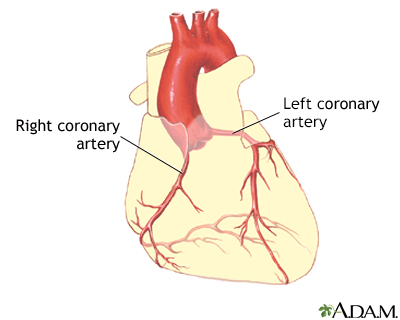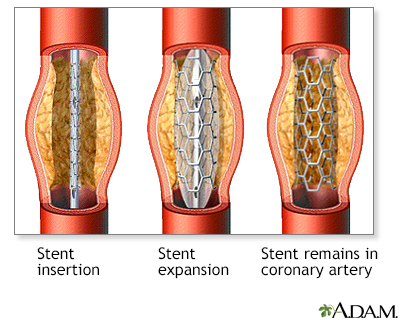Stent
A stent is a tiny tube placed into a hollow structure in your body. This structure can be an artery, a vein, or another structure, such as the tube that carries urine (ureter). The stent holds the structure open.

Coronary artery stent
An intraluminal coronary artery stent is a small, self-expanding, stainless steel mesh tube that is placed within a coronary artery to keep the vessel open. It may be used during a coronary artery bypass graft surgery to keep the grafted vessel open, after balloon angioplasty to prevent reclosure of the blood vessel, or during other heart surgeries.
Description
When a stent is placed into the body, the procedure is called stenting. There are different kinds of stents. Most are made of a metal or plastic mesh-like material. However, stent grafts are made of fabric. They are used in larger arteries.
A coronary artery stent is a small, self-expanding, metal mesh tube. It is placed inside a coronary artery after balloon angioplasty. This stent prevents the artery from re-closing.
Balloon angioplasty
The blood vessels that bring blood to your brain and face are called the carotid arteries. You have a carotid artery on each side of your neck. The...

A drug-eluting stent is coated with a medicine. This medicine helps further prevent the arteries from re-closing. Like other coronary artery stents, it is left permanently in the artery.
Stent - Animation
If you have a blocked artery in your heart, legs, or neck, you may need a stent to keep your blood flowing to prevent serious problems. Let's talk today about stents. A stent is a tiny tube we place in an artery, blood vessel, or other duct (such as the one that carries urine) to hold the tubes open. A stent is left in permanently. Most stents are made of metal or plastic mesh-like material. Stent grafts made of fabric are often used in larger arteries. Stents are used to treat a variety of artery and other problems. Your doctor will make a small cut in a blood vessel in your groin and thread a thin, flexible tube called a catheter to the place in your body where you need a stent. In the heart, a fatty substance called plaque can build up inside the coronary arteries. Plaque narrows the arteries, reducing the flow of oxygen-rich blood to the heart. One stent, called an intraluminal coronary artery stent, is a small, self-expanding, metal mesh-like tube that is placed inside a coronary artery after balloon angiography. This stent prevents the artery from re-closing. Another stent is coated with medicine that helps further prevent an artery from re-closing. In the carotid arteries, which are on both sides of your neck, plaque can build up and slow the flow of blood to your brain. Stents can keep the carotid arteries open. Stents can also open up narrow arteries in your legs caused by peripheral arterial disease. They're also used to treat an abdominal aortic aneurysm, which is when the large blood vessel that supplies blood to your abdomen, pelvis, and legs becomes abnormally large and balloons. After a stent procedure, your doctor will probably recommend that you take aspirin and another anti-clotting medication to prevent blood clots from forming in the stent. Make sure that you talk to your doctor, before getting a stent, about the risks associated with placing a stent to treat your condition, such as tissue growing around the area where the stent was placed.
Why the Procedure Is Performed
Most of the time, stents are used when arteries become narrow or blocked.
Stents are commonly used to treat the following conditions that result from blocked or damaged blood vessels:
- Coronary heart disease (CHD) (angioplasty and stent placement - heart)
Coronary heart disease
Coronary heart disease is a narrowing of the blood vessels that supply blood and oxygen to the heart. Coronary heart disease (CHD) is also called co...
 ImageRead Article Now Book Mark Article
ImageRead Article Now Book Mark Article - Peripheral artery disease (angioplasty and stent replacement - peripheral arteries)
Peripheral artery disease
Peripheral artery disease (PAD) is a condition of the blood vessels that supply the legs and feet. It occurs due to narrowing of the arteries in the...
 ImageRead Article Now Book Mark Article
ImageRead Article Now Book Mark Article - Renal artery stenosis
Renal artery stenosis
Renovascular hypertension is high blood pressure due to narrowing of the arteries that carry blood to the kidneys. This condition is also called ren...
 ImageRead Article Now Book Mark Article
ImageRead Article Now Book Mark Article - Abdominal aortic aneurysm (aortic aneurysm repair - endovascular)
Abdominal aortic aneurysm
The aorta is the main blood vessel that supplies blood to the abdomen, pelvis, and legs. An abdominal aortic aneurysm (AAA) occurs when an area of t...
 ImageRead Article Now Book Mark Article
ImageRead Article Now Book Mark Article - Carotid artery disease (carotid artery surgery)
Carotid artery disease
Carotid artery disease causes the carotid arteries to become narrowed or blocked. The carotid arteries provide part of the main blood supply to your ...
 ImageRead Article Now Book Mark Article
ImageRead Article Now Book Mark Article
Other reasons to use stents include:
- Keeping open a blocked or damaged ureter (percutaneous urinary procedures)
Keeping open a blocked or damaged urete
Injectable implants are injections of material into the wall of the urethra to help control urine leakage (urinary incontinence) caused by a weak uri...
 ImageRead Article Now Book Mark Article
ImageRead Article Now Book Mark Article - Treating aneurysms, including thoracic aortic aneurysms
Treating aneurysms
An aneurysm is an abnormal widening or ballooning of a part of an artery due to weakness in the wall of the blood vessel.
 ImageRead Article Now Book Mark Article
ImageRead Article Now Book Mark ArticleThoracic aortic aneurysms
An aneurysm is an abnormal widening or ballooning of a portion of an artery due to weakness in the wall of the blood vessel. A thoracic aortic aneury...
 ImageRead Article Now Book Mark Article
ImageRead Article Now Book Mark Article - Keeping bile flowing in blocked bile ducts (biliary stricture)
Keeping bile flowing in blocked bile du...
A bile duct stricture is an abnormal narrowing, most often of the common bile duct. This is a tube that moves bile from the liver to the small intes...
 ImageRead Article Now Book Mark Article
ImageRead Article Now Book Mark Article - Helping you breathe if you have a blockage in the airways
Risks
Related topics include:
- Angioplasty and stent placement - heart
Angioplasty and stent placement - heart
Angioplasty is a procedure to open narrowed or blocked blood vessels that supply blood to the heart. These blood vessels are called the coronary art...
 ImageRead Article Now Book Mark Article
ImageRead Article Now Book Mark Article - Angioplasty and stent placement - peripheral arteries
Angioplasty and stent placement - perip...
Angioplasty is a procedure to open narrowed or blocked blood vessels that supply blood to your legs. Fatty deposits can build up inside the arteries...
Read Article Now Book Mark Article - Percutaneous urinary procedures
Percutaneous urinary procedures
Percutaneous (through the skin) urinary procedures help drain urine from your kidney and get rid of kidney stones.
Read Article Now Book Mark Article - Transjugular intrahepatic portosystemic shunt (TIPS)
Transjugular intrahepatic portosystemic...
Transjugular intrahepatic portosystemic shunt (TIPS) is a procedure to create new connections between two blood vessels in your liver. You may need ...
 ImageRead Article Now Book Mark Article
ImageRead Article Now Book Mark Article - Carotid artery surgery
Carotid artery surgery
Carotid artery surgery is a procedure to treat carotid artery disease. The carotid artery brings needed blood to your brain and face. You have one o...
 ImageRead Article Now Book Mark Article
ImageRead Article Now Book Mark Article - Aortic aneurysm repair - endovascular
Aortic aneurysm repair - endovascular
Endovascular abdominal aortic aneurysm (AAA) repair is surgery to repair a widened area in your aorta. This is called an aneurysm. The aorta is the...
Read Article Now Book Mark Article - Thoracic aortic aneurysm
Thoracic aortic aneurysm
An aneurysm is an abnormal widening or ballooning of a portion of an artery due to weakness in the wall of the blood vessel. A thoracic aortic aneury...
 ImageRead Article Now Book Mark Article
ImageRead Article Now Book Mark Article
Reviewed By
Neil Grossman, MD, Saint Vincent Radiological Associates, Framingham, MA. Review provided by VeriMed Healthcare Network. Also reviewed by David C. Dugdale, MD, Medical Director, Brenda Conaway, Editorial Director, and the A.D.A.M. Editorial team.
Tambyraja AL. Vascular and endovascular surgery. In: Garden OJ, Parks RW, Wigmore SJ, eds. Principles and Practice of Surgery. 8th ed. Philadelphia, PA: Elsevier; 2023:chap 22.
Teirstein PS, Kirtane AJ. Interventional diagnosis and treatment of coronary artery disease. In: Goldman L, Cooney KA, eds. Goldman-Cecil Medicine. 27th ed. Philadelphia, PA: Elsevier; 2024:chap 59.
Textor SC. Renovascular hypertension and ischemic nephropathy. In: Yu ASL, Chertow GM, Luyckx VA, Marsden PA, Skorecki K, Taal MW, eds. Brenner and Rector's The Kidney. 11th ed. Philadelphia, PA: Elsevier; 2020:chap 47.
White CJ. Atherosclerotic peripheral arterial disease. In: Goldman L, Cooney KA, eds. Goldman-Cecil Medicine. 27th ed. Philadelphia, PA: Elsevier; 2024:chap 65.











 All rights reserved.
All rights reserved.